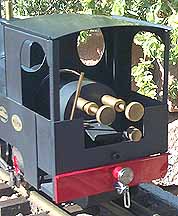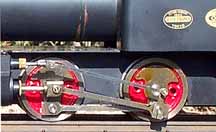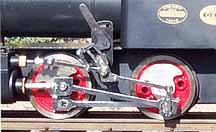
Back to Sidestreet Bannerworks
October 2001
Jetty 0-4-0T
by Marc Horovitz

The Jetty Company of Japan was established in 1955 by Mr. M. Hayashi. At that time the company produced model reciprocating racing engines. The company went on to develop small motorcycle racing engines and high-performance racing engines for automobiles (though whether for model or full-size cars is unknown). In 1977 the company began planning a line of model live-steam locomotives in 1:24 and 1:32, though nothing evidently came of this.
Live steam was once again approached in 1989, with the design and development of a small 0-4-0T based on a Krauss (German) industrial locomotive. This project came to fruition in the locomotive featured here, although it seems never to have been put into actual production. In addition to this fixed-cylinder engine, Jetty planned a similar locomotive with oscillating cylinders as well as models of US and Japanese prototypes. There were also some rumblings of locomotives in 2-1/2" gauge.
Jetty engines were to be sold through a marketing company, not directly. I suspect that this had something to do with the engines never seeing the light of day. With so many middle men, the ultimate retail price would have been prohibitive.
I never had any correspondence directly with Mr. Hayashi -- always through the marketing company. Unfortunately, this company had vastly inflated ideas about the size of the potential market for live-steam locomotives. The last communication I had with them was in 1996, at which time the release of the oscillating engine seemed imminent. If anyone knows anything more about Jetty, Mr. Hayashi, or his engines, I'd be pleased to hear from them.
The model
The Jetty engines are neatly made with an absolute minimum of detail. They feature Smithies boilers that run on alcohol. The burner is integral with the fuel tank and consists of two large wicks that appear to be tightly coiled ceramic sheet. This is accessible through a door in the firebox. The fuel tank itself is filled with absorbent ceramic cotton.
Since the boiler is internally fired, a suction fan and blower are required. The engines came with their own fans. Access to the boiler is through the safety valve.
The cylinders are nicely made, with gland nuts on both piston rod and valve rods. The first sample I received was not reversible, running off a traditional return crank. After some discussion with Mr. Hayashi (via the marketing company) a reversible model was produced. This incorporates a lever on the left-hand footplate that moves the radius rod up and down in a radial link, similar to the valve gear used by Roundhouse and others today. No lubricator is provided.
Performance
After the usual lubing, feeding, and watering, the engine was placed on the track and the fan popped onto the stack and turned on. The fire door was opened and a lit match inserted therein. After six or seven minutes (which seemed a long time to me for a small engine) signs of life appeared. I removed the fan and turned on the blower.
I have, in the past, gotten this engine to run fairly well. Today, however, the magic was gone. Steam seemed to be up, although the safety never lifted. I let it sit a little more after the fan was removed, then opened the throttle. The engine made one halfhearted circuit of the track, then gave it up.
I suspected burner trouble, so I removed the burner (which involves dropping the rear axle) and tweaked the wicks a little. I also changed alcohol, just in case my original stuff had taken on some water. The second firing seemed promising, at least at first. Steam came up a little faster and the safety lifted. However, when I opened the throttle, it was evident that the engine had additional, mechanical problems. One of these days I'll take it to pieces to find out just what they are.
In the best of times the engine ran only adequately. The boiler never seemed to have enough oomph to make the loco truly energetic. However, it would run languidly around for 15-20 minutes, with the fire door half open. It is an attractive engine and no doubt its problems could have been sorted out. It's basically a sound design and it's too bad that it was never made widely available.
| Specifications | |
| Builder | Jetty (Japan) |
| Date built | 1991 |
| Gauge | 45mm (gauge 1) |
| Scale | 1:22.5 |
| Boiler | Smithies |
| Fittings | Safety valve, throttle, blower |
| Fuel | Alcohol |
| Blow-off pressure | 30 psi (estimated) |
| Cylinders | Two, double-acting D-valve |
| Reversing gear | Simple eccentric with link, controlled by lever on left-hand footplate |
| Lubricator | None |
| Dimensions | Length over end beams, 8-12"; width, 3-5/8"; height over stack, 5-1/2" |





Above: Firing up with the suction fan.
Above right: The backhead. Throttle on the right, blower on the left. Below the throttle is the capped fuel filler tube.
Right: The burner alight on the bench.




Back to Sidestreet Bannerworks
This page and its contents Copyright Sidestreet Bannerworks, 2001